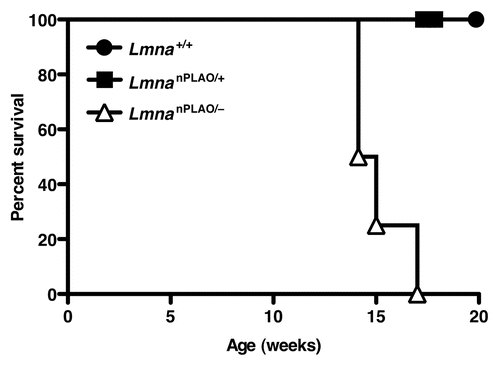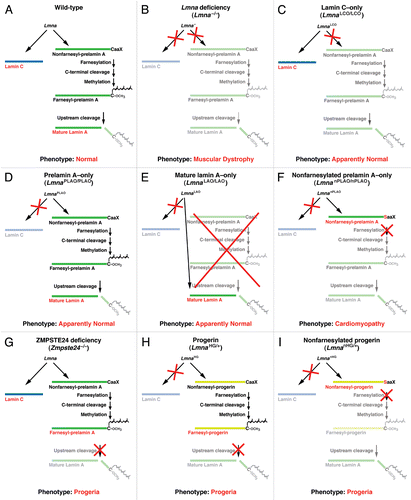Figures & data
Figure 1 Survival curves for Lmna+/+, LmnanPLAO/+ and LmnanPLAO/− mice. The survival time for male LmnanPLAO/− mice was shorter than for Lmna+/+ or LmnanPLAO/+ mice (n = 4 for each group) (p = 0.002). Previous studies showed that male LmnanPLAO/nPLAO mice had an average survival time of 38.5 weeks (a milder phenotype than LmnanPLAO/− mice),Citation33 suggesting that nonfarnesylated prelamin A is a poorly functioning lamin.

Figure 2 The effects of disrupting A-type lamin synthesis and processing in laboratory mice. (A) Wild-type mice produce both lamin C and prelamin A. Prelamin A then undergoes four sequential posttranslational processing steps to generate mature lamin A. (B) Lmna−/− mice produce neither lamin A nor lamin C. These mice have muscular dystrophy and die at 5–6 weeks of age.Citation5 (C) LmnaLCO/LCO mice produce only lamin C. These mice appear to be phenotypically normal.Citation42 (D) LmnaPLAO/PLAO mice do not produce lamin C. The prelamin A produced by these mice is efficiently converted to mature lamin A. These mice also appear to be normal.Citation33 (E) LmnaLAO/LAO mice produce mature lamin A directly, bypassing prelamin A synthesis and processing. These mice make no lamin C. Like LmnaLCO/LCO and LmnaPLAO/PLAO mice, LmnaLAO/LAO mice appear to be normal.Citation48 (F) LmnanPLAO/nPLAO produce exclusively nonfarnesylated prelamin A. Because of a cysteine-to-serine substitution in prelamin A's CaaX motif, the prelamin A cannot be farnesylated. These mice develop dilated cardiomyopathy and have reduced survival.Citation33 (G) Zmpste24-deficient mice produce both lamin C and prelamin A, but the final endoproteolytic step does not occur, resulting in the accumulation of farnesylated prelamin A. These mice display multiple progeria-like disease phenotypes.Citation16,Citation19 (H) In addition to making normal lamin C and prelamin A from one allele, LmnaHG/+ mice make a prelamin A with a 50-amino acid internal deletion (from the LmnaHG allele). This deletion prevents the final, ZMPSTE24-mediated, endoproteolytic step from occurring and leads to the accumulation of a farnesylated and truncated form of prelamin A called progerin. Despite the presence of normal forms of lamin A and lamin C, these mice develop progeria-like disease phenotypes.Citation28,Citation29 (I) LmnanHG/+ mice are identical to LmnaHG/+ mice except that the truncated prelamin A generated from the LmnanHG allele cannot be farnesylated (due to a cysteine-to-serine substitution in the CaaX motif), leading to the accumulation of nonfarnesylated progerin. These mice also have progeria, though it is somewhat less severe than that found in LmnaHG/+ mice.Citation22
